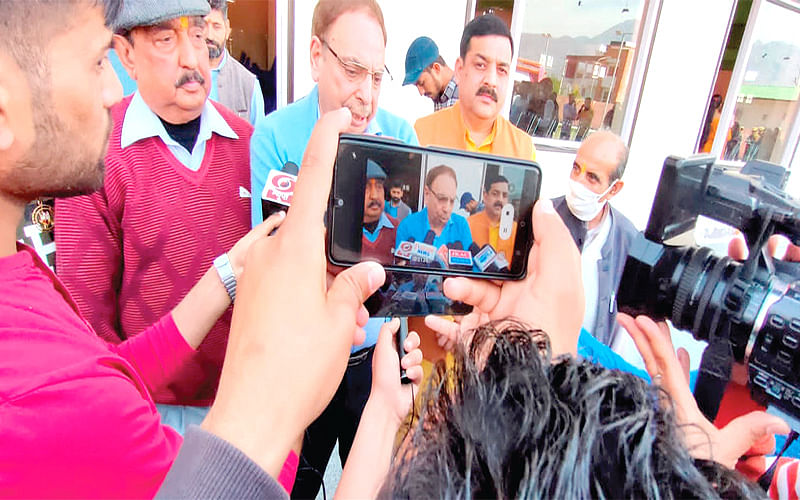Prof Upendra Kaul
The “No Heart Attack Mission 2025” is a slogan and a dream of the Gauri Kaul Foundation. We embarked on it on the World Heart Day, 29th September 2020. The concept is to work on the known modifiable risk factors of a heart attack (Myocardial Infarction) and make it known to the community at large by going to various districts of Jammu and Kashmir in the first instance. The need for this is very glaring, with younger ages getting affected in large numbers as seen and reported by most doctors caring for such patients both in the hospitals of the cities, towns and remote areas. We have set a target of 5 years to minimise the heart attacks and want all likeminded groups and public at large to join us in this endeavour.
It has been well established that 9 risk factors can explain 90% of the heart attacks occurring in the community, in both sexes and worldwide. This has been well documented after studying 15152 cases in the INTERHEART Study published in The Lancet in September 2004 by Salim Yusuf and colleagues from 52 countries. The basis of our approach is preventing acquisition of these risk factors.
Our awareness programs focus on the community, doctors, paramedics and all categories of healthcare workers. The last of our programs were held in district Reasi (Reasi town) and Jammu District (Jagti Migrant Township). Both the programs were well attended. The founder director of the Gauri Kaul Foundation, Prof U Kaul, addressed the gathering in both the places, while the CEO, Ajaz Rashid organised the events with the support of Chairman District development Council Shri Saraf Singh Nag and the District Development Commissioner Smt. Babila Rukwal.
What are these risk factors?
1. Smoking and use of tobacco products: There is a linear relationship of the possibility of the heart attack and the number of cigarettes smoked per day. More the number of cigarettes smoked, higher is the chance of getting it.
2. Dyslipidaemia: Abnormally high levels of bad cholesterol especially the LDL (Low Density lipoprotein) cholesterol levels. In Indians these levels should be less than 100 mgs/dl in healthy persons. In those with a previous heart attack these should be at least < 70 mgs/dl and preferably < 55 mgs/dl.
3. High Blood pressure: Normal BP is less than 120/80 mms Hg. More than 120/80 is defined as high BP. Any body having BP more than 140/90 mms Hg needs drug treatment under care of a physician. The target for less than 65 years of age is <130/80 and for more than 65 years of age is 140/90.
4. Diabetes Mellitus: A cut off of a random blood sugar of above 140 mgs is the most accepted definition in Indians, this corresponds to a HbA1c (Glycosylated Hb level of 6.5%). A level between 6 to 6.5% is called Pre diabetic.
5. Waist Hip ratio (Truncal obesity): For men it should be less than 0.95 and for women, 0.85. other well-known measurements, Body Mass Index (BMI), Normal less than 23kg/me2 and Waist circumference (WC); Normal for men <85cms and for women < 80 cms. High levels are risk factors for getting a heart attack
6. Psychosocial Stress: It is a consequence of imbalance between the adverse events in day-to-day life and the ability to cope with it. Examples include, divorce, death of a child, very competitive environment at the place of work etc.
7. Lack of regular intake of fresh fruits and vegetables. Five to 6 servings (one bowl) per day protects, and lack of it becomes an adverse risk factor.
8. Lack of Regular Exercise: More than 30 minutes of physical exercise (walking, running, sporting activity etc ) at least 5 times a week protects and lack of it makes one prone to get a heart attack.
9. Alcohol Consumption: A regular modest intake has been considered as a protective factor. This however was not so in South Asians including Indians and is never promoted because of other bad effects of this vice.
It is also important to note that when these risk factors are present in combinations the chances of getting a heart attack multiply several folds.
How to Overcome: Life style modifications are the best and most cost-effective method of preventing the acquisition of these. No smoking, regular exercise, consuming plenty of fresh fruit and vegetables, reducing body weight and adopting relaxing measures like meditation, listening to light music and other simple techniques as a habit. Early recognition of high BP, high cholesterol levels, diabetes also goes a long way in preventing a heart attack. Periodic once a year check ups in healthy people is one of the good ways of early detection and prompt management of the adverse risk factors.
Tailpiece: Heart attacks are on an increase and consume a significant portion of our population in the prime of life either as a tragic death or making them disabled. Smoking, abnormally high lipids, high BP, diabetes, obesity, psychosocial factors, lack of intake of fresh fruits and vegetables and sedentary life style explain 90% of the Heart attacks. Approaches of prevention are easy and doable. Beginning them early in life and managing these is imminently feasible. It is the need of the hour.
Prof Upendra Kaul Founder Director, Gauri Kaul Foundation. Recipient of Padma Shri and Dr B C Roy Award
Disclaimer: The views and opinions expressed in this article are the personal opinions of the author. The facts, analysis, assumptions and perspective appearing in the article do not reflect the views of GK.







